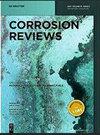Graphene-based coatings for magnesium alloys: exploring the correlation between coating architecture, deposition methods, corrosion resistance and materials selection
IF 2.7
4区 材料科学
Q3 ELECTROCHEMISTRY
引用次数: 3
Abstract
Abstract Graphene and its derivatives have attracted much interest as corrosion-resistant coatings for magnesium alloys since 2014, when the first reports appeared in the literature. The interest in the use of such carbonaceous compounds to protect magnesium and its alloys from corrosion relies on a set of attributes such as chemical inertness, and high surface area. To support the development of optimized graphene-based films it is imperative to expand the current knowledge toward a deeper understanding of corrosion mechanisms and their interaction with practical aspects related to coating deposition and morphology. In the present work, graphene-based coatings for magnesium alloys are reviewed. We explored the correlation between coating architecture, deposition methods and materials selection using the Ashby approach. The results of the materials selection process revealed that composite coatings consisting of an inorganic matrix obtained by plasma electrolytic oxidation of magnesium alloys and graphene oxide nanosheets as blocking agents can provide surfaces with high corrosion resistance in sodium chloride solution. For biomedical applications, composite coatings consisting of a mixture of organic matrices such as chitosan and graphene oxide as reinforcing particles are attractive candidates. The results are discussed based on coating architecture and its interplay with the corrosion properties.镁合金用石墨烯基涂层:探讨涂层结构、沉积方法、耐腐蚀性和材料选择之间的关系
自2014年以来,石墨烯及其衍生物作为镁合金的耐腐蚀涂层引起了人们的极大兴趣,当时文献中出现了第一批报道。使用这种碳质化合物来保护镁及其合金免受腐蚀的兴趣依赖于一系列属性,如化学惰性和高表面积。为了支持优化的石墨烯基薄膜的发展,必须扩大现有的知识,以更深入地了解腐蚀机制及其与涂层沉积和形态相关的实际方面的相互作用。本文综述了镁合金石墨烯基涂层的研究进展。我们使用Ashby方法探索了涂层结构、沉积方法和材料选择之间的关系。材料选择过程的结果表明,由镁合金等离子体电解氧化获得的无机基体和氧化石墨烯纳米片作为阻隔剂组成的复合涂层可以提供高耐氯化钠溶液腐蚀的表面。对于生物医学应用,由壳聚糖和氧化石墨烯等有机基质的混合物组成的复合涂层作为增强颗粒是有吸引力的候选者。从涂层结构及其与腐蚀性能的相互作用等方面对结果进行了讨论。
本文章由计算机程序翻译,如有差异,请以英文原文为准。
求助全文
约1分钟内获得全文
求助全文
来源期刊

Corrosion Reviews
工程技术-材料科学:膜
CiteScore
5.20
自引率
3.10%
发文量
44
审稿时长
4.5 months
期刊介绍:
Corrosion Reviews is an international bimonthly journal devoted to critical reviews and, to a lesser extent, outstanding original articles that are key to advancing the understanding and application of corrosion science and engineering in the service of society. Papers may be of a theoretical, experimental or practical nature, provided that they make a significant contribution to knowledge in the field.
 求助内容:
求助内容: 应助结果提醒方式:
应助结果提醒方式:


